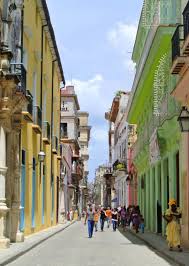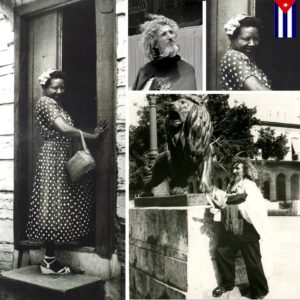 LA “MARQUESA” AND JUAN “CHARRASQUEADO”: TWO CHARACTERS FROM MY OLD HAVANA.
LA “MARQUESA” AND JUAN “CHARRASQUEADO”: TWO CHARACTERS FROM MY OLD HAVANA.
In the memories of our Old Havana, there were well-known characters that even today are remembered with sympathy from a past that will not return.
Starting with the so-called “Marquesa”, this fragile little person, very black, short, short and broad, although she did not carry a drop of blue blood in her veins, she was more “real” than many royal highnesses.
She was a contemporary of the ‘Knight of Paris’ and walked through the Central Park of Havana where tourists abounded with cameras on their shoulders. Every day she passed by the Godoy-Zayán offices, the insurance and banking office, where they gave her cash to bring coffee with milk and bread and butter for all the employees (it was not customary to ask for toast). Her real name was Isabel Veitia, La Marquesa Isabel Veitía, but she preferred to be called Marquesa.
La Marquesa, by a billico, allowed herself to be photographed, but not before identifying herself as the La Marquesa she believed herself to be. She wore a small purple hat with a tulle veil. A half-put mantilla and a little black patent leather bag hung from her shoulders. To further accentuate her ridiculousness and attract attention, she constantly fanned herself with great grace and femininity and wore shiny gold-colored plastic shoes.
Just a silly tacky joke, seasoned with the proverbial mischief she spilled, made unsuspecting walkers laugh, as she opened the bag and said gracefully – Tickets, just bills! I am a Marchioness! My condition does not allow me to accept coins, said Isabel Veitía with grace.
JUAN CHARRASQUEADO. ANOTHER CHARACTER NOT FORGOTTEN.
Juan Charrasqueado is the character of a revolutionary Mexican corrido, it was probably based on a real character, although it should be remembered that the revolutionary soldiers were called “juanes” and the charrasqueado indicates that this particular Juan had scars from wounds from charrasca (small knife, razor, machete, faca). It was the name and the central character of a film by Pedro Armendariz and a song by Jorge Negrete. The corridos were generally a kind of newspaper in the Mexico of the Revolution, since it recounted the main events that took place in the region, narrating war actions or simply the most famous events of the time to those who could not read them, who were the majority.
But our Juan “Charrasqueado” wandered the streets of Havana wearing an outfit that, more than a Mexican charro, would look like a Texan cowboy dressed for a Sunday. But he was proud and showed himself as a Mexican charro, and that is how he always lived, with this fixed idea. He attended the very named Club de los Noctámbulos singular Bar-Club on 308 Teniente Rey Street, where the Knight of Paris also went. A chronicler of the time defined them as the sanest madmen in Cuba.
Many Cubans saw him more than once touring Old Havana and it seemed that he was a character from Mexican movies who was visiting Havana.
 LA MARQUESA Y JUAN CHARRASQUEADO: DOS PERSONAJES DE LA HABANA VIEJA.
LA MARQUESA Y JUAN CHARRASQUEADO: DOS PERSONAJES DE LA HABANA VIEJA.
En los recuerdos de nuestra Habana Vieja existieron conocidos personajes que aún hoy se les recuerdas con simpatia de un pasado que no volvera.
Empezando por la llamada “Marquesa”, esta frágil personita, bien negra, de poca estatura, cortica y ancha, aunque no llevó en sus venas ni una gota de sangre azul, pero fue más “real” que muchas altezas reales.
Fue contemporánea del ‘Caballero de París’ y se paseaba por el Parque Central de La Habana donde abundaban los turistas con cámaras fotográficas al hombro. Todos los días pasaba por las oficinas de Godoy-Zayán, el de los seguros y banca, donde le daban dinero en efectivo para que trajera para todos los empleados el café con leche y el pan con mantequilla (no se acostumbraba a pedir tostadas). Su nombre verdadero era Isabel Veitia, La Marquesa Isabel Veitía, pero ella prefería que la llamaran Marquesa.
La Marquesa, por un billetico se dejaba fotografiar, no sin antes identificarse como La Marquesa que creía ser. Usaba un pequeño sombrero color morado con un velito de tul. Colgaba de sus hombros una mantilla a medio poner y una carterita negra de charol. Para acentuar aún más su ridiculez y llamar la atención, se abanicaba constantemente con mucha gracia y feminidad y calzaba unos brillantes zapatos plásticos de color dorado.
Sólo una broma tonta de mal gusto, sazonada con la proverbial picardía que ella desparramaba, hacía reír a los desprevenidos caminantes, mientras ella abría la bolsa y decía con gracia — ¡Billetes, sólo billetes. Yo soy una Marquesa! Mi condición no me permite aceptar monedas, decía con gracia Isabel Veitía.
JUAN CHARRASQUEADO. OTRO PERSONAJE NO OLVIDADO.
Voy a cantarles un corrido muy mentado
Lo que ha pasado allí en la hacienda de la flor
La triste historia de un ranchero enamorado
Que fue borracho, parrandero y jugador,
Juan se llamaba, y lo apodaban charrasqueado,
Era valiente y arriesgado en el amor,
A las mujeres más bonitas se llevaba
Y en esos campos no quedaba ni una flor.
Juan Charrasqueado es el personaje de un corrido mexicano revolucionario, probablemente fuera basado en un personaje real, aunque habría que recordar que a los soldados revolucionarios se les llamaba “juanes” y lo de charrasqueado indica que éste Juan en particular, tenía cicatrices de heridas de charrasca (cuchillo pequeño, navaja, machete, faca). Fue el nombre y el personaje central de una película de Pedro Armendariz y una canción de Jorge Negrete. Los corridos generalmente eran una especie de periódico en el México de la Revolución, pues contaba los principales acontecimientos sucedidos en la región, narrando acciones de guerra o simplemente los hechos más sonados de la época a quienes no podían leerlas, que eran la mayoría.
Pero nuestro Juan “Charrasqueado” deambulaba por las calles de la Habana vistiendo un atuendo que más que un charro mexicano, parecería un cowboy tejano vestido de domingo. Pero él se sentía orgulloso y se mostraba como un charro mexicano, y así vivió siempre, con esta idea fija. Concurría al muy nombrado Club de los Noctámbulos singular Bar-Club en la calle Teniente Rey 308, a donde también iba el Caballero de París. Un cronista de la época los definió como los locos más cuerdos de Cuba.
Muchos cubanos lo vieron más de una vez recorriendo la Habana Vieja y parecía que era un personaje de las películas mexicanas que estaba de visita en La Habana.
Agencies/ MemoriasCubanas/ Carlos Rodriguez/ Internet Photos/ Arnoldo Varona/ www.TheCubanHistory.com
THE CUBAN HISTORY, HOLLYWOOD.











